Community, Vulnerability, and Sustainability: Healing Trauma through Clothing
- Sophia Kagan

- Feb 28, 2024
- 6 min read
Updated: Aug 2, 2024
By Sophia Kagan
Edited by Marian Mohamed
Part 2 of The Healing of the Fashion Industry series
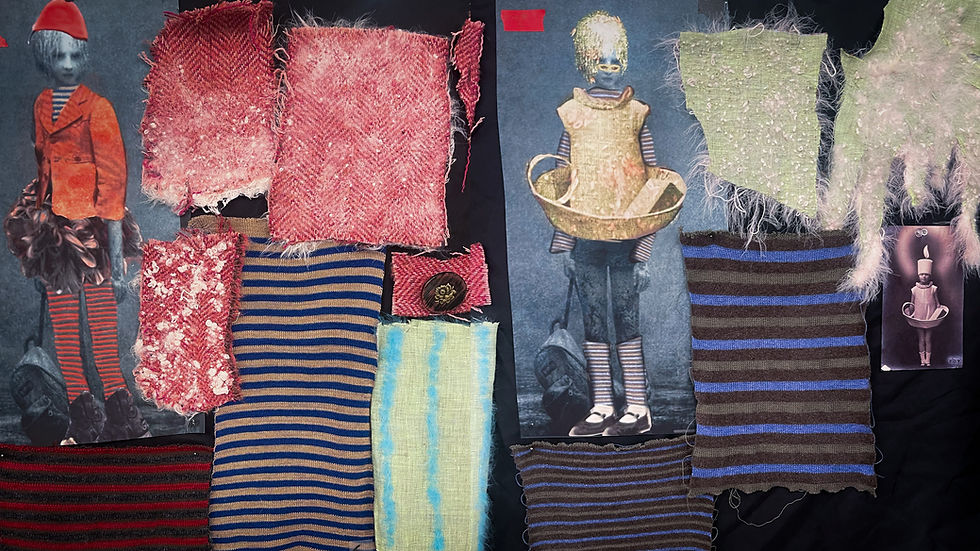
The design process of Pipenco’s knitwear. (Photo courtesy of Lorena Pipenco)
Fashion designers Becca Flood, Anna Roth, and Lorena Pipenco all have the experience of surviving an environment where they were isolated, or even hurt by others. To persevere in such circumstances, these designers use fashion as a way to connect to those around them. They create a shared experience of vulnerability as a way to heal and reimagine the future for themselves. To create such a condition, Flood, Roth, and Pipenco use customized textiles that shape the wearer's sensory experience, and allow the designers to become closer to others.
“ I create for angry girls, hilarious women, and those who love them”
Becca Flood
Becca Flood draws similarities to Alexander McQueen’s background in her own work. She struggled to reconcile her family relations and witnessed not only sexism, but also the extreme negativity that can come from domestic power dynamics between men and women. At the beginning of her thesis year, Flood’s inspiration for her collection was the story of a kid who killed their mom and threw the body in a blueberry field. This vivid imagery stemmed from a place of anger against the way she was treated as a child by adult figures.
Two months before her thesis was due, Flood decided to remake the concept for her collection. She focused less on the critiques of her professors and fellow classmates, and decided to make something that was truly authentic to herself. In her current work, Flood expresses herself in patchwork fabrics, tinted with light colors, prints crafted from drawings of horses, and delicate knits.
Flood says that “to be emotional is to be strong.” The legacy Flood wants to leave is to give young women the role model she needed but never had. She adds to the legacy of women in the fashion industry; women who create vulnerable work for a demographic that is often bombarded by sexist messaging by mainstream media.
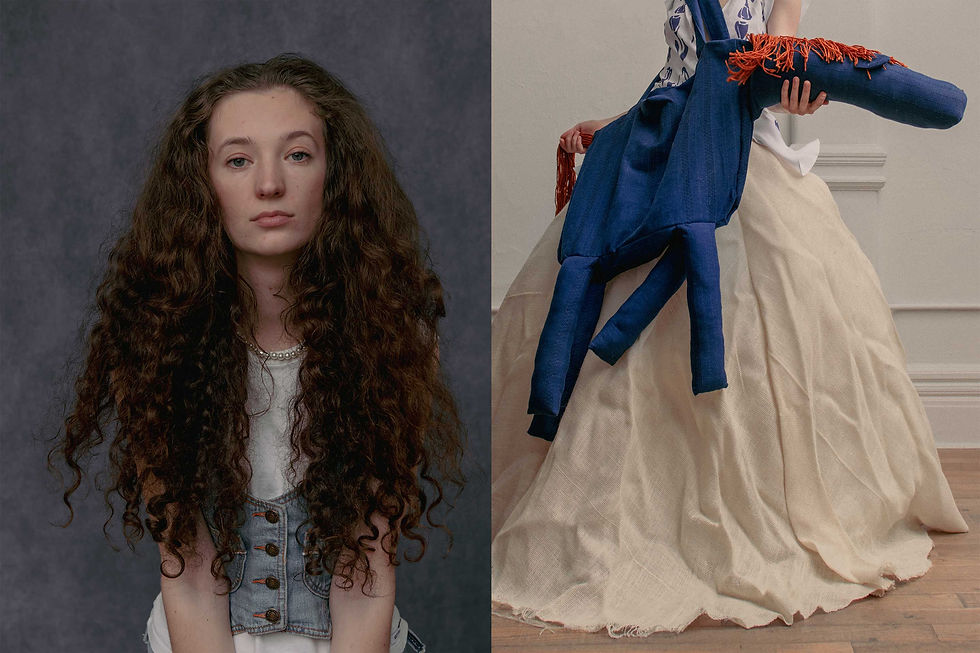
Left: Image of designer Becca Flood. Right: image of Hubert horse bag. (Photo courtesy of Becca Flood)
One of the ways that Flood empowers young women is to deviate from the constrictive stereotypes of women’s clothing. She uses unconventional materials that come from sustainable sources. A popular accessory she is currently selling, the Hubert horse bag, is made solely from upcycled materials. Despite her efforts to be as sustainable as possible, Flood acknowledges that “since [she is] selling at such a low price point to make clothes that are financially accessible, sustainable alternatives aren’t feasible in every garment”. She plans to become more sustainable as her brand receives more outside support.
When it comes to fabrics, Flood uses a variety of textile manipulations to represent her connection to the rural landscape of the Hudson Valley. Growing up in the Hudson Valley, Flood engaged with the healing qualities of nature. In her thesis, she designed a garment for the wearer to pick apples in. Flood also discusses her plans on using her dog’s baby teeth that her mom collected over the years, and creating a digital print from scans of the teeth. The motifs stemming from the designer’s experiences in the Hudson Valley, such as apples and dogs, serve as a nostalgic reminder to be in touch with oneself by interacting with wildlife.
Flood infuses her childhood memories into her work to visually transport the wearer into her childhood, and embolden them to explore their own roots.
“Each collection is a different chapter of the novel that is my brand”
Lorena Pipenco
Growing up in London as a Romanian, Pipenco struggled with her dual heritage. She was treated like an outsider, and even discriminated against. The designer still remembers when others yelled slurs at her. Nowadays, Pipenco takes the courageous step to tap back into her roots, with the goal of providing space for those with dual heritage.
Pipenco doesn't just tell her own stories, she tells the stories of her family through her designs. She often calls her loved ones for connection and inspiration. Her family often tells her about life in the USSR. These stories, which Pipenco holds close to her, are often vulnerable and traumatic experiences of what her family endured during the Soviet occupation of Romania. To break the cycle of generational trauma, Pipenco spins these stories into a positive view.
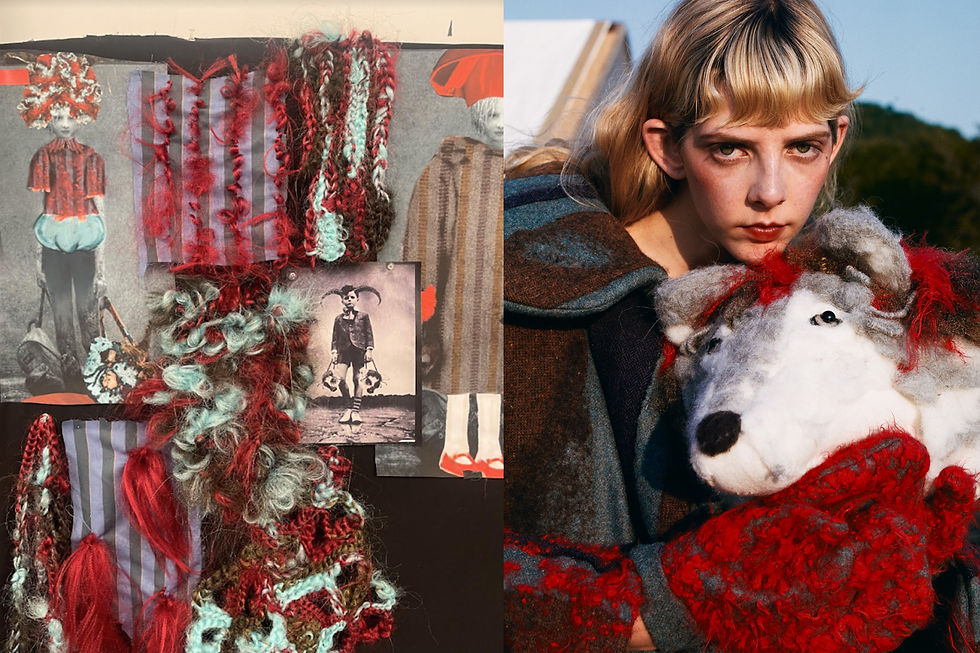
Left: design process of Pipenco’s knitwear. Right: look from Pipenco’s MFA thesis. (Photo courtesy of Lorena Pipenco)
Pipenco has a unique way of retelling her family’s stories. The designer uses the conceptual fashion technique of distortion, a term she coined specifically for her work. Distortion, Pipenco explains, “is the visual recontextualization of tradition and memory as a way of healing.” Pipenco demonstrated this technique when she upcycled a used crocheted tablecloth to create a blue bodysuit in her MFA thesis collection. Pipenco imagines that the tablecloth saw many beautiful moments before she received it, like quiet moments of her family enjoying a shared meal by candlelight, or a hearty discussion between two loved ones that are full of laughter and smiles. She infuses the memories of the tablecloth into her garment, which gives the garment an unexplainable feeling of connection.
The glimpses of her childhood memories can be expressed in Romanian art such as the 70’s Romanian animations “Veronica” and “Maria Mirabella”. These films create a magical anthropomorphic world, where animals use magic to bring happiness to their friends. Such fantasy lands heavily inspire Pipenco. She observes that “audiences are getting tired of fashion without narrative”, and uses stories as an antidote to an impersonal industry that prioritizes trends and consumerism.
Pipenco keeps a positive mindset, and admits she might have repressed negative emotions. The designer keeps a boundary between what she exposes and what she hides in her work. Pipenco questions whether it is fair or not to herself to do so but acknowledges that her designs are a reaction rather than a solution to the marks that trauma leaves behind.
“Creating an immersive experience is the way I collaborate with my audience.”
Anna Roth
Anna Roth’s dance and colorguard background saved her in tough times. Dancing allowed her to use movement as a way to heal her mental struggles and cultivated the idea of creating communities through her performances. Her MFA thesis was to reach out to others to build community. Roth’s art process is completely personal. Although her research is analytical, and takes inspiration from scientific knowledge about healing, the core of her designs are driven by her emotions.
When Roth moved from Oregon to New York City, she moved without a community. Roth started from scratch, and looked toward other people’s methods of building their own support system. She jokes that she even looked up Wiki articles about how to build a support system.
Roth’s collection How to Fit In uses humor to showcase the collective unity created by shared emotional hardships. Before her thesis, Roth created a small collection. The clothing acted as a facilitator for coping with anxiety and depression. She created heating pads, and fabricated different panels in her garments. Roth even added frilly back pieces for people to ‘pet’ the wearer. Sustainability is infused in the healing quality of her garments, not only helping people, but also the planet.
Roth explains her upcycling methods; “I repurpose my fabrics often [and] my character Wobbles in the Parsons MFA show I am cutting up to reuse in a future look. During my time at the Parsons MFA Program, I was a frequent visitor of the Textile Donations Center in the Parsons MFA building, and I sourced many of my fabrics there”.
Roth has a unique take on clothing, by combining costume design with fashion. “I use traditional craft materials to combine my costume design roots and the crafty and playful attitude I want to cultivate,” Roth said.
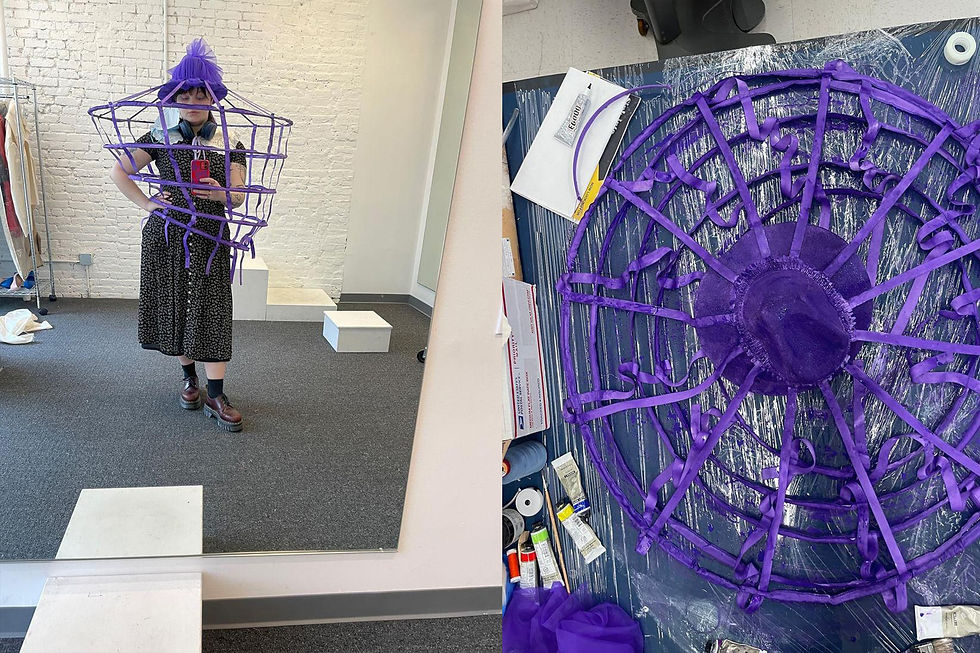
The design process of Wobbles from the “Fitting In” collection. (Photo courtesy of Anna Roth)
There are various ways to be an artist, but art is often more powerful when it comes from a personal place. Finding unexpected ways to heal is crucial amidst a world where everyone experiences a variety of hardships. Breaking the cycle of hurt is incredibly beautiful when done through art, and as Roth puts it, it can even heal communities.
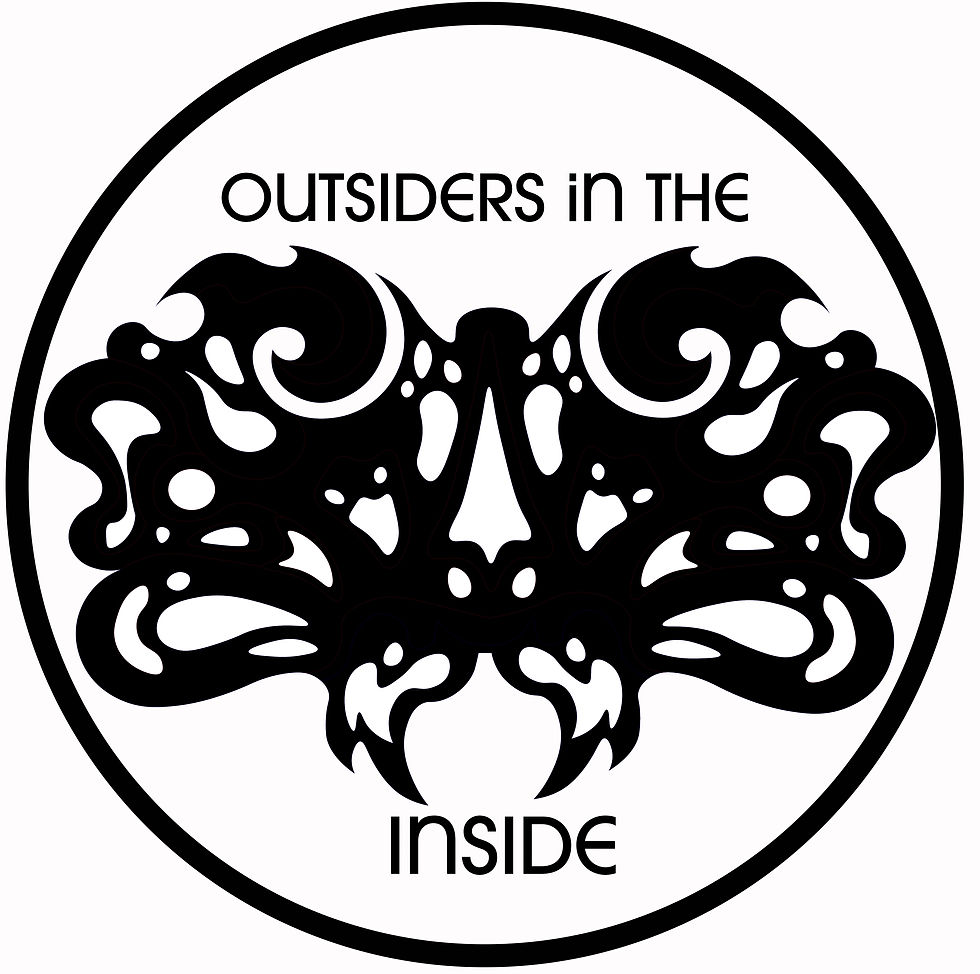
An abstract butterfly flourishing in a circular frame with the text “Outsiders in the Inside.” (Design by Sophia Kagan)











Comments